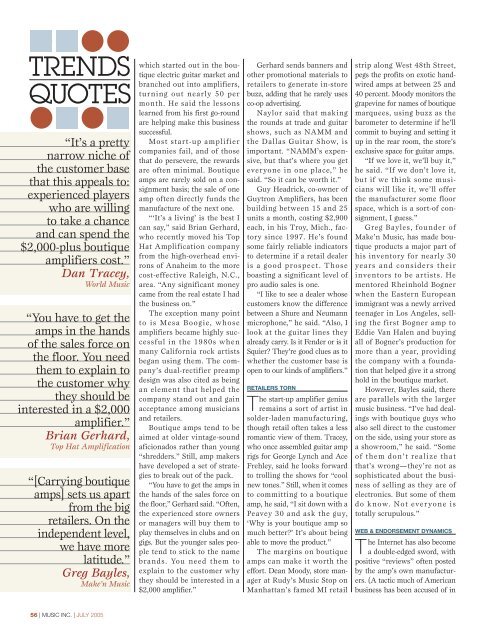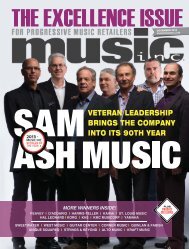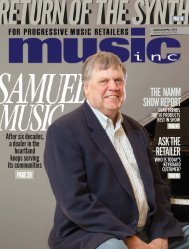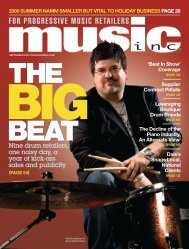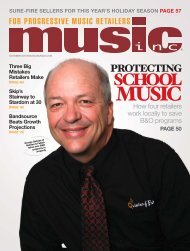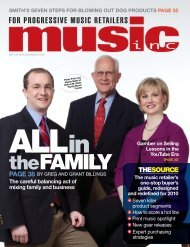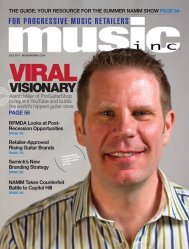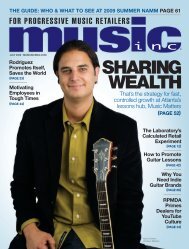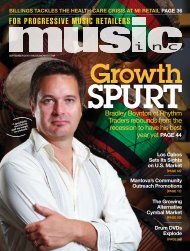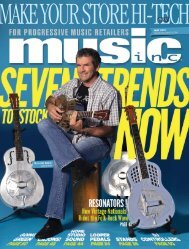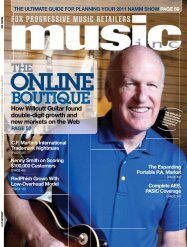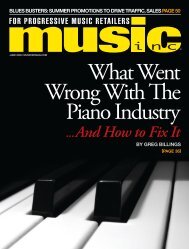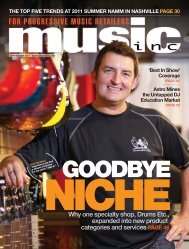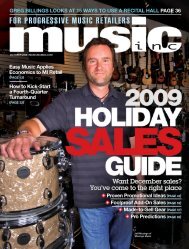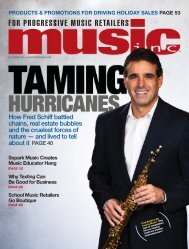The Boutique Amp Gamble - Music Inc. Magazine
The Boutique Amp Gamble - Music Inc. Magazine
The Boutique Amp Gamble - Music Inc. Magazine
Create successful ePaper yourself
Turn your PDF publications into a flip-book with our unique Google optimized e-Paper software.
“It’s a pretty<br />
narrow niche of<br />
the customer base<br />
that this appeals to:<br />
experienced players<br />
who are willing<br />
to take a chance<br />
and can spend the<br />
$2,000-plus boutique<br />
amplifiers cost.”<br />
Dan Tracey,<br />
World <strong>Music</strong><br />
“You have to get the<br />
amps in the hands<br />
of the sales force on<br />
the floor. You need<br />
them to explain to<br />
the customer why<br />
they should be<br />
interested in a $2,000<br />
amplifier.”<br />
Brian Gerhard,<br />
Top Hat <strong>Amp</strong>lification<br />
“[Carrying boutique<br />
amps] sets us apart<br />
from the big<br />
retailers. On the<br />
independent level,<br />
we have more<br />
latitude.”<br />
Greg Bayles,<br />
Make’n <strong>Music</strong><br />
56 | MUSIC INC. | JULY 2005<br />
which started out in the boutique<br />
electric guitar market and<br />
branched out into amplifiers,<br />
turning out nearly 50 per<br />
month. He said the lessons<br />
learned from his first go-round<br />
are helping make this business<br />
successful.<br />
Most start-up amplifier<br />
companies fail, and of those<br />
that do persevere, the rewards<br />
are often minimal. <strong>Boutique</strong><br />
amps are rarely sold on a consignment<br />
basis; the sale of one<br />
amp often directly funds the<br />
manufacture of the next one.<br />
“‘It’s a living’ is the best I<br />
can say,” said Brian Gerhard,<br />
who recently moved his Top<br />
Hat <strong>Amp</strong>lification company<br />
from the high-overhead environs<br />
of Anaheim to the more<br />
cost-effective Raleigh, N.C.,<br />
area. “Any significant money<br />
came from the real estate I had<br />
the business on.”<br />
<strong>The</strong> exception many point<br />
to is Mesa Boogie, whose<br />
amplifiers became highly successful<br />
in the 1980s when<br />
many California rock artists<br />
began using them. <strong>The</strong> company’s<br />
dual-rectifier preamp<br />
design was also cited as being<br />
an element that helped the<br />
company stand out and gain<br />
acceptance among musicians<br />
and retailers.<br />
<strong>Boutique</strong> amps tend to be<br />
aimed at older vintage-sound<br />
aficionados rather than young<br />
“shredders.” Still, amp makers<br />
have developed a set of strategies<br />
to break out of the pack.<br />
“You have to get the amps in<br />
the hands of the sales force on<br />
the floor,” Gerhard said. “Often,<br />
the experienced store owners<br />
or managers will buy them to<br />
play themselves in clubs and on<br />
gigs. But the younger sales people<br />
tend to stick to the name<br />
brands. You need them to<br />
explain to the customer why<br />
they should be interested in a<br />
$2,000 amplifier.”<br />
Gerhard sends banners and<br />
other promotional materials to<br />
retailers to generate in-store<br />
buzz, adding that he rarely uses<br />
co-op advertising.<br />
Naylor said that making<br />
the rounds at trade and guitar<br />
shows, such as NAMM and<br />
the Dallas Guitar Show, is<br />
important. “NAMM’s expensive,<br />
but that’s where you get<br />
everyone in one place,” he<br />
said. “So it can be worth it.”<br />
Guy Headrick, co-owner of<br />
Guytron <strong>Amp</strong>lifiers, has been<br />
building between 15 and 25<br />
units a month, costing $2,900<br />
each, in his Troy, Mich., factory<br />
since 1997. He’s found<br />
some fairly reliable indicators<br />
to determine if a retail dealer<br />
is a good prospect. Those<br />
boasting a significant level of<br />
pro audio sales is one.<br />
“I like to see a dealer whose<br />
customers know the difference<br />
between a Shure and Neumann<br />
microphone,” he said. “Also, I<br />
look at the guitar lines they<br />
already carry. Is it Fender or is it<br />
Squier? <strong>The</strong>y’re good clues as to<br />
whether the customer base is<br />
open to our kinds of amplifiers.”<br />
RETAILERS TORN<br />
<strong>The</strong> start-up amplifier genius<br />
remains a sort of artist in<br />
solder-laden manufacturing,<br />
though retail often takes a less<br />
romantic view of them. Tracey,<br />
who once assembled guitar amp<br />
rigs for George Lynch and Ace<br />
Frehley, said he looks forward<br />
to trolling the shows for “cool<br />
new tones.” Still, when it comes<br />
to committing to a boutique<br />
amp, he said, “I sit down with a<br />
Peavey 30 and ask the guy,<br />
‘Why is your boutique amp so<br />
much better?’ It’s about being<br />
able to move the product.”<br />
<strong>The</strong> margins on boutique<br />
amps can make it worth the<br />
effort. Dean Moody, store manager<br />
at Rudy’s <strong>Music</strong> Stop on<br />
Manhattan’s famed MI retail<br />
strip along West 48th Street,<br />
pegs the profits on exotic handwired<br />
amps at between 25 and<br />
40 percent. Moody monitors the<br />
grapevine for names of boutique<br />
marquees, using buzz as the<br />
barometer to determine if he’ll<br />
commit to buying and setting it<br />
up in the rear room, the store’s<br />
exclusive space for guitar amps.<br />
“If we love it, we’ll buy it,”<br />
he said. “If we don’t love it,<br />
but if we think some musicians<br />
will like it, we’ll offer<br />
the manufacturer some floor<br />
space, which is a sort-of consignment,<br />
I guess.”<br />
Greg Bayles, founder of<br />
Make’n <strong>Music</strong>, has made boutique<br />
products a major part of<br />
his inventory for nearly 30<br />
years and considers their<br />
inventors to be artists. He<br />
mentored Rheinhold Bogner<br />
when the Eastern European<br />
immigrant was a newly arrived<br />
teenager in Los Angeles, selling<br />
the first Bogner amp to<br />
Eddie Van Halen and buying<br />
all of Bogner’s production for<br />
more than a year, providing<br />
the company with a foundation<br />
that helped give it a strong<br />
hold in the boutique market.<br />
However, Bayles said, there<br />
are parallels with the larger<br />
music business. “I’ve had dealings<br />
with boutique guys who<br />
also sell direct to the customer<br />
on the side, using your store as<br />
a showroom,” he said. “Some<br />
of them don’t realize that<br />
that’s wrong—they’re not as<br />
sophisticated about the business<br />
of selling as they are of<br />
electronics. But some of them<br />
do know. Not everyone is<br />
totally scrupulous.”<br />
WEB & ENDORSEMENT DYNAMICS<br />
<strong>The</strong> Internet has also become<br />
a double-edged sword, with<br />
positive “reviews” often posted<br />
by the amp’s own manufacturers.<br />
(A tactic much of American<br />
business has been accused of in


